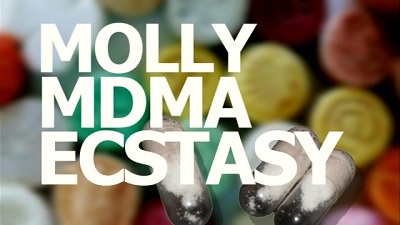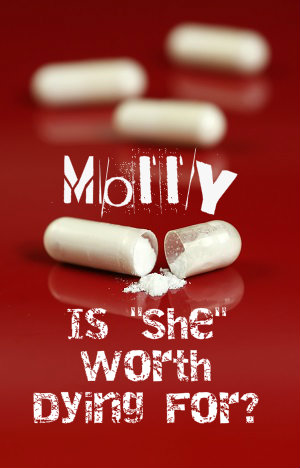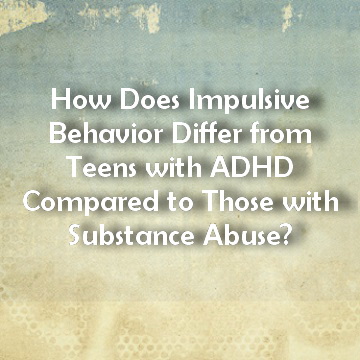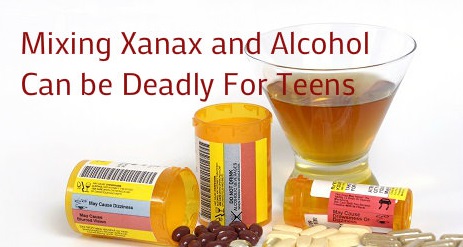Searching for the ultimate high, teens share drugs, mix drugs and succumb to the ill after-effects that drugs impose on them. They are often smart enough to know that the drug will make them feel awful after the high has worn away, but addiction doesn’t respond well to this reasoning. To truly break a drug addiction, teens need professional guidance and treatment.

Courtesy of: www.pentagonpost.com
Molly, also known as ecstasy or MDMA, promises teens an exhilarating feeling. In an NBC news report, one young man said that he was lured by the intense high that Molly gave him. He was looking for something new and someone suggested to him that Molly was like a new form of the drug ecstasy.
MDMA’s Short High And Dangerous Side-effects
His first encounters with Molly made him feel great. He said that the drug made him feel very happy and excited. He felt on top of the world and it was exactly what he was looking for. But the happiness didn’t last long and the young man soon realized that the short time he was high came with a long sentence of feeling completely worn out, both physically and mentally.
When teens search for a great high, they don’t think about the ill effects the drug may cause. Part of that comes from living in the moment and not worrying about the consequences. Some might even say the consequences are worth it. But over time, the consequences get more intense, and like a wheel racing downhill they can’t find a way to stop, event when the consequences become too overwhelming and change their life for the worst.
When self-esteem plummets and fatigue becomes overwhelming, some teens may try to stop using by themselves. Molly causes withdrawal symptoms like heavy sweating, overheating, high blood pressure, extreme dehydration and in some cases death. It can also affect teens psychologically, sometimes causing short term psychosis.
How Addiction To Molly Takes You To A New Low
The young man who was interviewed by NBC said that he knew he was letting Molly control him when he started selling his child’s toys in order to get money for drugs. He could not believe the person that he had become and how his need for the drug had changed him so much. He had also been lured by the media, knowing that popular movie stars and musicians were using the drug.
Recovery From The Lows Of Molly
The only way he was able to break free from Molly was through a treatment center that guided him back into better mental and physical health. Through his experience he cautions teens to stay away from the lure of that high that inevitably and impersonally drops you off into the lowest low.
For nearly a quarter century now the state of Indiana has been conducting a youth substance use survey. The data is used to direct prevention and intervention strategies and to gauge how well those efforts are working. The most recent annual survey of alcohol, tobacco and other drug use, the Indiana Youth Survey 2013, reflects current trends in teen behaviors and attitudes and shows that some interventions are proving successful.
 The survey questioned 117,554 teens from private and public schools attending grades six through senior in high school. The survey is conducted in conjunction with the Indiana Prevention Resource Center who makes resources available to schools and communities aimed at curbing teen substance abuse.
The survey questioned 117,554 teens from private and public schools attending grades six through senior in high school. The survey is conducted in conjunction with the Indiana Prevention Resource Center who makes resources available to schools and communities aimed at curbing teen substance abuse.
Use of marijuana by teens (12 to 17 years) hit an all-time high in the state between 2008 and 2011. The good news is that the most recent survey shows that marijuana use is now falling among teens there. However, while marijuana use is dropping, its use is still seen as too high, and synthetic marijuana use is an increasing concern.
Synthetic Marijuana Use Dangerously Increasing
Synthetic marijuana is just what it sounds like — a man-made substance that mimics marijuana. It is made by drying plant material and then spraying it with chemicals which mirror the effects of marijuana and THC. The plant material is then chopped and marketed in stores as incense, but kids roll it and smoke it just like natural marijuana. In fact, the survey shows that teens are not substituting fake marijuana for real marijuana but are using the two drugs simultaneously.
This year’s survey included new questions related to risk factors and protective factors that influence teen drug use. Questions pertaining to the health of relationships and attitudes reveal the degree of risk or protection teens are experiencing. The attitudes of parents and friends about drug use influences teens greatly, as do how well relationships at home, school and among peers are faring.
Prescription Drug Abuse
The survey found that prescription drug abuse increases with age. Less than two percent of sixth graders reported abusing prescription drugs, but more than 14 percent of seniors admitted using. The survey was specific in asking teens if they bought prescription drugs from friends or obtained them from family members. Since a major protective factor against prescription drug abuse is a teen’s perception of danger, the survey highlights the need for more information and better education strategies letting kids know just how dangerous misuse of prescription drugs can be.
Other news found in this year’s survey included success in lowering the numbers of teens who engage in gambling (online, lottery, slot machines etc.). Teen gambling rates have dropped in Indiana and the survey revealed that teen regret/remorse over gambling is increasing.
Parents may now find more reason to monitor their teen’s use of social networking sites: Teens that see social networking pictures of their buddies partying with alcohol and tobacco are much more likely to use those substances.
 The study was conducted by a team from the University of Southern California (USC) Keck School of Medicine that questioned 1,563 sophomore students from a Los Angeles high school on two separate occasions — once in October 2010 and then again in April 2011. Researchers asked the teens about friendships they had online through social media and also about their face-to-face friendships. They asked teens how often they utilized social networking sites and which ones they tended to use. They also asked teens about whether or not they themselves ever smoked tobacco or drank alcohol.
The study was conducted by a team from the University of Southern California (USC) Keck School of Medicine that questioned 1,563 sophomore students from a Los Angeles high school on two separate occasions — once in October 2010 and then again in April 2011. Researchers asked the teens about friendships they had online through social media and also about their face-to-face friendships. They asked teens how often they utilized social networking sites and which ones they tended to use. They also asked teens about whether or not they themselves ever smoked tobacco or drank alcohol.
The USC study, which was published in the Journal of Adolescent Health, is among the first to carefully investigate the way social networking behavior affects the use of alcohol and tobacco among teens.
High School Study Participants
The student participants were equally divided between girls and boys and the average age was 15. The study population generally reflected the racial make-up of the high school with one quarter of participants being Asian and two-thirds Hispanic. Right around 50 percent of the students involved in the study said they were regular visitors to social networking sites like Facebook or MySpace.
Around 30 percent of the high school students questioned said they had smoked cigarettes and above 50 percent of them said they had tried alcohol. One-third of the students said that they had a minimum of one friend who either smoked cigarettes or drank alcohol. The baseline was important in gauging how much viewing other students’ behavior might be considered as influencing their own.
When questioned, 20 percent of the students said that they had friends who posted pictures online of smoking, drinking and partying. Another 34 percent of the students said that they had at least one friend who mentioned partying (especially drinking or smoking tobacco) in their online discussions or postings. Between October 2010 and April 2011 the student use of Facebook increased by 75 percent and use of MySpace rose by 13 percent.
Results On Teens From Alcohol Posting On Social Networks
After analyzing the data, researchers found that teens are definitely influenced by online photos of their friends’ behavior, saying it didn’t seem to matter whether a teen had many or fewer friends in their network. What did seem to matter was what kind of pictures were posted by those friends.
Even if a teen did not have close, face-to-face friendships with kids who drank or smoked, they were nevertheless at risk for being affected by more exposure to pictures of those behaviors posted online. In other words, peer pressure and peer influence definitely extends into cyberspace.
The research backed up prior findings that show a difference between users of Facebook and MySpace. Teens that were only on Facebook tended to speak more English, come from higher social strata and get better grades. They also tended to not be Hispanic and were less likely to have ever tried smoking or drinking. Users of MySpace primarily tended to drink more, and the more they used MySpace the more they tended to drink.
Since 95 percent of American teens (ages 12 to 17) are online and 80 percent stay connected through sites like Facebook, these findings are extremely relevant. It isn’t only who kids hang out with at home or on the soccer field — it matters who teens connect with online. When kids are online there are any number of friends that parents may never meet in person.
24 Sep 2013
Do Teens Know the Truth About Molly?
Who is Molly? Molly is the new name for the decades-old drug ecstasy, the drug that was responsible for three deaths and four people being hospitalized in critical condition over this past Labor Day weekend.
Description Of Molly
Molly is a synthetic, or man-made, drug. It first showed up on the streets in the 1980s as ecstasy. At the time it was called a club drug because young people enjoyed taking it when they went dancing, attended concerts or large parties. Today it’s sold in powder form, usually in capsule form but also sold as pills or tablets, with “Molly” connoting molecular purity.
 The pills are brightly colored and sometimes emblazoned with cartoonish images. Officially the drug is known as MDMA, which stands for 3,4-Methylenedioxymethamphetamine. If you saw a few words in there you thought you recognized like amphetamine and meth you were right. The drug is a stimulant, or amphetamine, resembling methamphetamine in the way it increases heart rate and stimulation while providing feelings of euphoria.
The pills are brightly colored and sometimes emblazoned with cartoonish images. Officially the drug is known as MDMA, which stands for 3,4-Methylenedioxymethamphetamine. If you saw a few words in there you thought you recognized like amphetamine and meth you were right. The drug is a stimulant, or amphetamine, resembling methamphetamine in the way it increases heart rate and stimulation while providing feelings of euphoria.
MDMA is a concoction combining a stimulant with an empathy-boosting chemical plus a psychedelic. Kids like to take Molly at large group events because the drug makes them feel more energized, less inhibited and closer to those around them. There’s also a sensation of heightened alertness.
Molly’s Risks
There’s also a down-side as it can lead to blurry vision, racing blood pressure and heartbeat and muscle cramps. Sometimes the person’s insides are so revved up that they develop hyperthermia. Long hours of dancing and pressing up against people in a crowd make heat stroke likely. Increased heart rate can easily become an arrhythmia or erratic heartbeat, and seizures have also been known to occur.
MDMA may ratchet up energy and perception but it often pulls down the user’s emotions, leaving them feeling depressed, sad and anxious. Problems with memory can result and these difficulties sometimes last up to a week or more. When a young person decides to mix MDMA with alcohol they increase the sedative effects as well as increasing their risk of becoming dehydrated.
The risk of dehydration with use of MDMA is real, so lots of users try to compensate by drinking more water. However, since it causes the body to retain fluids, the combination of MDMA and water can quickly create an imbalance of electrolytes. Kids who choose to combine Molly with caffeine increase their risk of dehydration while also dangerously increasing body temperature.
Impure MDMA
Called Molly because of supposed molecular purity, the drug is no more pure than any other illicit drug. In fact, MDMA is often cut or completely replaced with another substance known as PMA which produces similar effects. Some deaths attributed to MDMA have actually been caused by PMA. More than that, street drugs are made with no regulating oversight, meaning every batch is unique and users can’t expect one tablet to affect them precisely the same as the last. Many high profile deaths come about because a celebrity is using street drugs in a new city and expecting them to be exactly like those they used in another city — it just doesn’t happen that way.
Celebrity Push Of Molly
Ecstasy, MDMA, Molly — whatever you call it, the drug is enjoying renewed popularity spurred on by pop singers like Madonna, Kanye West and Miley Cyrus. The Monitoring the Future studies conducted by the National Institute on Drug Addiction report that MDMA is experiencing a resurgence among 20-somethings and even high schoolers.
Strong Opportunity For Parents And Teachers
The recent tragic deaths at the Electronic Music Festival in New York provide an opportunity for parents and teachers to talk with teens about the realities of using drugs like MDMA. No matter what pop singers or friends might say, no experience is worth dying for.
05 Sep 2013
Mixing Xanax and Alcohol Can be Deadly For Teens
If you look up the number one prescribed medication in the United States you will find Xanax at the very top of the list. The anti-anxiety medication is so widely prescribed these days that it can be found in a shockingly high number of American households. Used to treat anxiety and panic disorders, the drug is also commonly prescribed for patients complaining of high stress. Despite the fact that Xanax has recently been implicated in some high profile overdose deaths, the drug continues to enjoy widespread popularity.
Xanax is part of a family of drugs known as diazepines. Its chemical designation is Alprazolam and in 2009, 44 million prescriptions for the drug were written. By 2011 diazepine prescriptions were numbering above 260 million, of which Xanax represents the lion’s share.
Dangerous Quick High
Unfortunately the drug is not only popular with patients and their doctors but with young adults and teens looking for a quick drug-induced escape from reality. Teens like Xanax because it is so accessible – just grab one out of mom or dad’s medicine cabinet, right? – but also because the drug offers such a quick “high.” Within just 10 or 15 minutes users can feel an extreme high or low sensation. Users also experience accentuated symptoms of sedation like slurred speech, droopy eyes and other kinds of psychomotor retardation. Essentially, the person feels like they are drunk on alcohol.
Xanax provides a quick high because it is metabolized quickly, but the high ends just as fast as it comes on. The problem is that the drug also induces a state of memory impairment that is akin to blacking out. This creates a high risk situation since the person senses the absence of the sought after feelings but cannot remember that they recently took a pill, leaving them quite likely to pop another one. Taking even two Xanax in a short amount of time can have serious consequences.
Unfortunately, many who abuse Xanax also abuse alcohol. This means that users are taking two depressants at the same time. It is just like doubling up on Xanax in terms of risk. Drinking along with taking a Xanax may double the high, but it also ratchets up the risk factor – ingesting two strong depressants can slow down respiration (breathing) and the central nervous system to hazardously low levels.
Symptoms of Use
Symptoms of Xanax use include slowed heartbeat, trouble concentrating, slowed breathing, sleepiness, confusion and loss of memory. According to reports from the Substance Abuse and Mental Health Services Administration more than 60,000 hospital admissions were the result of Xanax abuse in 2008. Since prescription rates for the drug have steadily climbed by 9 percent annually, current figures can be expected to vastly outstrip that number.
Benzodiazepines like Xanax are medically appropriate when used to help epileptics prevent serious seizures. The drug is sometimes prescribed to treat insomnia but warnings abound recommending that the drug only be used short-term for treating sleeplessness. It is probably most commonly prescribed to calm symptoms of generalized anxiety disorder, but again the drug is recommended only for short-term use, not more than one month.
Xanax works by increasing activity of the brain’s own soothing mechanism. Neurotransmitters known as GABA are naturally occurring sedatives. When these neurotransmitters are abnormally excited long-term a physical and psychological dependence (addiction) can result.
What this means is that it is not hard at all for people using Xanax to quickly feel like they need the drug in order to cope. Tolerance is a term which describes how the body adjusts to the presence of medications and eventually requires more of a substance in order to produce similar results. Teens who take Xanax can wind up addicted to the drug before they know it.
If a teen is mixing Xanax – or any medication recreationally – with alcohol, the potential for addiction skyrockets, as does the risk of lethal consequences.
02 Sep 2013
Taking Drugs to Boost Grades
For some, college was a time for sleeping in and goofing off. For others, memories of college are associated with stress as students worked to achieve good grades while juggling intense academic requirements, extracurricular activities and relationships with a new level of personal responsibility.
The stakes are high. Students understand that their grades will help them secure a good job with financial security. Competition can be fierce to not only be accepted into but also remain in specialty colleges within the university that teach skills to teachers, therapists, accountants and engineers.
 “Smart Drugs” Not so Smart
“Smart Drugs” Not so Smart
Recently, ABC affiliate 13WHAM of Rochester, New York, highlighted one way that students choose to handle the pressure – misusing prescription stimulants to increase focus and eliminate the need for sleep, known as “smart drugs.”
Adderall is just one brand name drug that students abuse as a study aid. Prescribed to treat attention deficit hyperactivity disorder (ADHD), the drug is so widely issued by doctors that students find it relatively easy to obtain as friends may be willing to sell their extra pills.
A study published in The Addiction Journal indicated that the problem is becoming widespread. One in four college students indicate they have used pills to get through an exam or other stressful academic situation.
The 13WHAM story profiles an individual under the pseudonym of Steve who regularly uses stimulants to meet academic requirements. He said the medication increases focus and avoid sleeping, allowing for a 72-hour straight study session he did when taking 60 milligrams of Adderall, which paid off with good grades.
Adderall Abuse & Risks
Adderall abuse is becoming more common and the effects of the drug can lead to increased medical interventions and the need for emergency care.
Students are unaware of or underestimate the risks associated with the misuse of prescription drugs. They may believe that prescription drugs are somehow safer than street drugs or that there isn’t a risk of mixing drugs with other medications. Experts, on the other hand, warn that the drugs can be extremely dangerous, with adverse reactions including stroke, heart attack and psychotic episodes.
13WHAM reported that university health center doctors were seeing increased attempts by students to get prescriptions for stimulants as finals approached. The physicians said that while they are generally able to help students who have a diagnosis for ADHD, it takes more than one exam session to determine whether a student is abusing stimulants.
What Parents Can Do
Parents should take time to talk to their college-age children about the risks of using stimulants. They can also speak openly about their opinions and rules related to substance use. While students enjoy an increased level of freedom at college, many are still receptive to their parents’ viewpoint while they are receiving support, both financial and otherwise.
While parents may doubt their influence, particularly after their teen has left home to pursue a degree, studies show that parents play an important role. Teens who abstain from substance use repeatedly indicate that their parents were influential in helping them decide not to use substances.
Parents can also be a source of support for their college-age child as they face the intense pressure and competition to succeed in school. Keeping an open conversation about the challenges and expectations involved with getting a degree may help a student avoid making poor decisions related to stress management.
When it comes to teen alcohol and drug use, it seems like there’s always a new method that young people are finding to get high – chugging cough medicine, sniffing glue, snorting bath salts or mixing old medications found in the family medicine cabinet. While it’s normal to be curious, one poor decision can change a person’s life forever.
That’s why authorities and health officials are concerned about a dangerous new trend: smoking alcohol. Because the lungs have such a large surface area, alcohol is absorbed at a much quicker rate when it is inhaled using vaporizers, i.e.: dry ice and bicycle pumps connected to old plastic bottles.
Breathalyzer Comparison
According to Dwayne Baird, spokesperson for the Utah Department of Public Safety, one reason individuals may choose to inhale alcohol is because they believe it won’t show up on a breathalyzer. But Baird says that anyone who understands how the test works knows that a breathalyzer assesses the blood alcohol content and inhaling alcohol actually leads to a higher concentration.
Another reason that people choose to smoke alcohol instead of drink it is that inhaling directly into the lungs delivers a quicker, more intense high. Under normal circumstances, alcohol would be consumed then pass through the body’s stomach and liver where it takes time to metabolize. Dr. Barbara Crouch, Executive Director for Utah Poison Control, equates the practice to binge drinking – when too much alcohol is consumed too quickly, the body has a difficult time successfully processing all of it.
Baird says that the Department of Public Safety still runs across more cases of normal alcohol consumption than it does inhalation methods, but with information able to spread rapidly through social media sites, its popularity with teens could spike quickly.
Scary Results
The body has normal ways of signaling that it has had too much alcohol. When someone drinks to excess, the body responds by causing a person to vomit. That doesn’t happen when alcohol is inhaled. Instead, it passes straight through the lungs into the bloodstream and up to the brain. The problem with that, says Baird, is that it’s difficult for a person to tell when they’ve reached their limit.
Young people in particular tend to regard themselves as invincible and often don’t consider the consequences of their actions or how such consequences might impact their future. But inadvertent alcohol poisoning is a real and even bigger threat when inhaling than drinking alcohol.
22 Aug 2013
How Does Impulsive Behavior Differ from Teens with ADHD Compared to Those with Substance Abuse?
Impulsive behavior, known more formally as impulsivity, is behavior that occurs spontaneously or with only minimal forethought or preparation. For a number of reasons, teenagers generally act impulsively more frequently than adults. Impulsivity in teens with attention-deficit hyperactivity disorder (ADHD) has been linked to increased risks for involvement in alcohol, drug and cigarette use. However, according to the results of a study published in 2012 in the journal Nature Neuroscience, the roots of the impulsive behavior found in teens with ADHD differ significantly from the roots of the impulsive behavior associated with teen substance use.
Teen Impulsivity Basics
The human brain relies on a specific region, called the frontal cortex, to perform and regulate such higher-level tasks as making judgments or decisions, gaining perspective on self-motivation and controlling fleeting or momentary urges. However, during adolescence, the frontal cortex is not completely formed. This lack of brain development goes a long way toward explaining why teenagers tend to act impulsively, even when they receive information from adults that’s designed to offset impulsivity. The authors of another study, published in 2009 in the American Psychological Association’s American Psychologist, concluded that teens age 16 and older actually have enough brain development to reason in a manner similar to adults. However, teens in this age group still generally lack the emotional maturity to adequately or consistently control their impulsive behaviors.
the frontal cortex is not completely formed. This lack of brain development goes a long way toward explaining why teenagers tend to act impulsively, even when they receive information from adults that’s designed to offset impulsivity. The authors of another study, published in 2009 in the American Psychological Association’s American Psychologist, concluded that teens age 16 and older actually have enough brain development to reason in a manner similar to adults. However, teens in this age group still generally lack the emotional maturity to adequately or consistently control their impulsive behaviors.
Impulsivity and ADHD
Along with hyperactivity, impulsivity forms one of the two basic symptoms of ADHD. Impulsive urges in a teenager (or younger child or adult) affected by the disorder may manifest as a generally high level of impatience, a tendency to frequently interrupt others, an inability to wait patiently in different situations, a general lack of emotional restraint, a tendency to disregard unpleasant outcomes of one’s actions, or an inability to tailor one’s words appropriately for a given social situation. Some teens with ADHD have prominent symptoms of impulsivity and hyperactivity, while others have little or no problems with hyperactivity/impulsivity and instead have significant problems maintaining focus or attention.
Connections to Substance Use
In the past, researchers have clearly linked the presence of ADHD to increased risks for substance use in teenage populations. In the study, published in Nature Neuroscience, a multinational research team explored this link by periodically examining the brain function of 1,896 adolescents. These teens were all age 14 when the study began, and underwent brain scans at two-year intervals over the next four years. During these scans, all participants were asked to perform tasks that measured their level of self-control. The researchers also used medical histories to determine how many of the study’s participants had symptoms of ADHD. In addition, they periodically asked the participants about their level of involvement with alcohol, drug and cigarette use.
After reviewing their findings, the authors of the study concluded that the presence of ADHD itself does not reduce teenagers’ ability to control their impulsive urges. Similarly, they concluded that teens who use substances also don’t generally have a reduced ability to control their impulses. This does not mean that teens who have ADHD or use substances don’t act impulsively; it simply means that teens with these issues apparently don’t typically act impulsively any more often than teens unaffected by these issues. Critically, the authors of the study also concluded that when teens with ADHD do act impulsively, their behaviors are triggered by different brain pathways than the pathways that trigger impulsive participation in substance use. This finding suggests that the presence of ADHD-related impulsivity is not as likely to contribute to substance use risks as scientists once commonly believed.
Considerations
Interestingly, the authors of the study in Nature Neuroscience also concluded that the brain pathways that contribute to impulsivity-related substance use kick into gear even when some teenagers use only minimal amounts of a given substance. This finding strongly suggests that substance use itself does not lead to increased impulsivity in adolescents. Instead, the reverse is likely true, with the preexisting effects of impulsivity contributing to increased participation in substance use. In real-world terms, this means that some teenagers may have longstanding or built-in impulsive tendencies that make them much more susceptible to substance use (and subsequent problems with substance abuse or addiction) than other teenagers who come from similar backgrounds, belong to similar peer groups and participate in similar sorts of daily activities.
“The take-home message is that impulsivity can be decomposed, broken down into different brain regions,” says Hugh Garavan, one of the study authors. “The functioning of one region is related to ADHD symptoms, while the functioning of other regions is related to drug use.”




